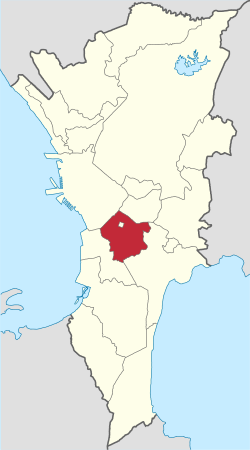
Back ماكاتي Arabic ماكاتى ARZ Makati BCL Макати Bulgarian Makati CBK-ZAM Makati CEB Makati Czech Makati German Μακάτι Greek Makatjo Esperanto
This article possibly contains original research. (July 2021) |
Makati | |
|---|---|
|
| |
| Etymology: San Pedro [de] Macati | |
| Nickname: Financial Capital of the Philippines | |
| Motto(s): Makati, Mahalin Natin, Atin Ito. ("Makati, let us love it, it is ours.") | |

| |
Location within the Philippines | |
| Coordinates: 14°33′24″N 121°01′17″E / 14.5567°N 121.0214°E | |
| Country | Philippines |
| Region | National Capital Region |
| Province | none |
| District | 1st and 2nd district |
| Founded | June 1, 1670 |
| Renamed | February 28, 1914 (as Makati) |
| Cityhood | February 4, 1995 |
| Recent territorial change | November 9, 2023 |
| Barangays | 23 (since 2023) |
| Government | |
| • Type | Sangguniang Panlungsod |
| • Mayor | Abigail Binay (MKTZNU/NPC) |
| • Vice Mayor | Monique Lagdameo (MKTZNU) |
| • Representatives | |
| • City Council | Members |
| • Electorate | 458,362 voters (2022) |
| Area | |
• Total | 18.17 km2 (7.02 sq mi) |
| Elevation | 32 m (105 ft) |
| Highest elevation | 465 m (1,526 ft) |
| Lowest elevation | 0 m (0 ft) |
| Population (2020 census)[3] | |
• Total | 292,743 |
| • Density | 16,111/km2 (41,730/sq mi) |
| • Households | 89,638 |
| Demonym(s) | Makiteño; Makatizen |
| Economy | |
| • Income class | 1st city income class |
| • Poverty incidence | 0.80 |
| • HDI | |
| • Revenue | ₱ 19,259 million (2022) |
| • Assets | ₱ 238,262 million (2022) |
| • Expenditure | ₱ 19,651 million (2022) |
| • Liabilities | ₱ 15,695 million (2022) |
| Service provider | |
| • Electricity | Manila Electric Company (Meralco) |
| Time zone | UTC+8 (PST) |
| ZIP code | 1200–1213, 1219–1235 |
| PSGC | |
| IDD : area code | +63 (0)02 |
| Native languages | Tagalog |
| Major religions | Roman Catholic Church |
| Feast date | December 12 |
| Catholic diocese | Roman Catholic Archdiocese of Manila |
| Patron saint | Saints Peter and Paul, Virgen de la Rosa |
| Website | www |
Makati (/məˈkɑːti/ mə-KAH-tee; Tagalog pronunciation: [mɐˈkaː.t̪ɪ]), officially the City of Makati (Filipino: Lungsod ng Makati), is a highly urbanized city in the National Capital Region of the Philippines, known for being one of the leading financial centers in the country. As of 2013, the city has the highest concentration of multinational and local corporations in the Philippines.[5] Major banks, corporations, department stores as well as foreign embassies are based in Makati. Makati is also known for being a major cultural and entertainment hub in Metro Manila.[6] According to the 2020 census, it had a population of 629,616 people,[3] making it as the 47th most populous city in the country and ranked as the 43rd most densely populated city in the world with 19,336 inhabitants per square kilometer or 50,080 inhabitants per square mile.
In 2023, the ten Embo barangays were removed from Makati's jurisdiction as a result of the Makati–Taguig boundary dispute ruling, resulting in a reduction of the city's population to about 292,743. The daytime population of the city is estimated to be more than three million during a typical working day because of the large number of people who go to the city to work, shop, and do business.[7][8]
Cite error: There are <ref group=lower-alpha> tags or {{efn}} templates on this page, but the references will not show without a {{reflist|group=lower-alpha}} template or {{notelist}} template (see the help page).
- ^ City of Makati | (DILG)
- ^ "2015 Census of Population, Report No. 3 – Population, Land Area, and Population Density" (PDF). Philippine Statistics Authority. Quezon City, Philippines. August 2016. ISSN 0117-1453. Archived (PDF) from the original on May 25, 2021. Retrieved July 16, 2021.
- ^ a b Census of Population (2020). "National Capital Region (NCR)". Total Population by Province, City, Municipality and Barangay. Philippine Statistics Authority. Retrieved July 8, 2021.
- ^ "PSA Releases the 2021 City and Municipal Level Poverty Estimates". Philippine Statistics Authority. April 2, 2024. Retrieved April 28, 2024.
- ^ "About Makati, Philippines". Makaticity.com. Retrieved June 5, 2013.
- ^ "Tourist information and services on Makati City Philippines". Touristcenter.com.ph. Retrieved March 26, 2013.
- ^ "NATIONAL CAPITAL REGION (NCR) > Makati City". Department of Tourism. 2009. Archived from the original on February 3, 2014. Retrieved May 23, 2013.
- ^ Cite error: The named reference
basicfactswas invoked but never defined (see the help page).













